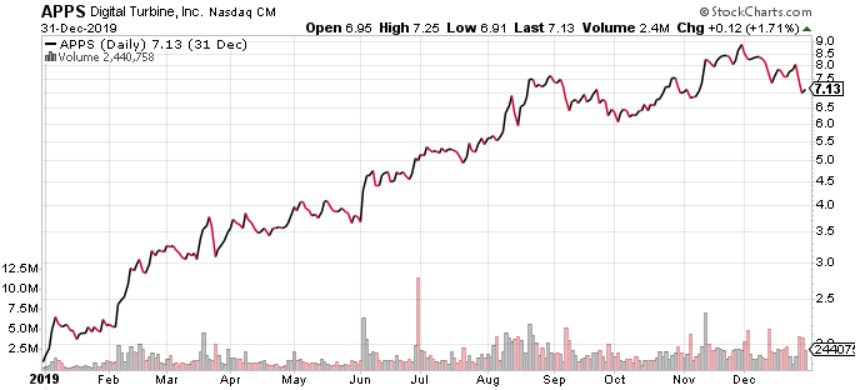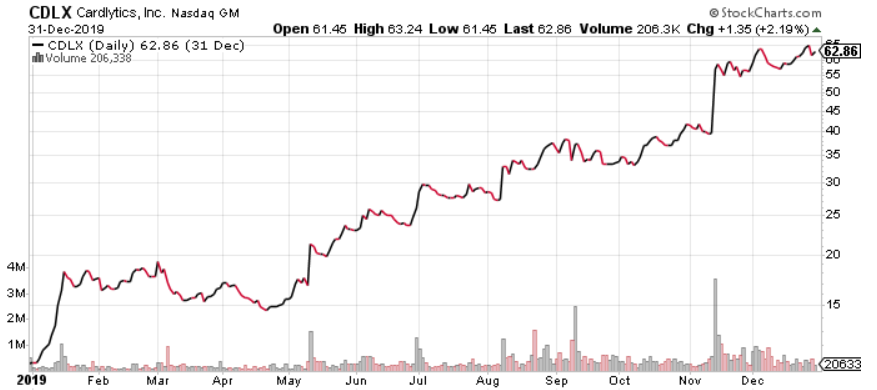Why 2020 Could Be a Big Year for Tech Stocks
Marijuana Business, Stocks, Finance, & Investing January 29, 2020 MJ Shareholders 0

 Big Profits From the Tech Sector?
Big Profits From the Tech Sector?
The technology sector is known for delivering huge profits. And you don’t need to get lucky on an initial public offering (IPO) to score a big win.
Over the past 12 months, the S&P 500 Information Technology index returned a whopping 53.3%, substantially outperforming the broader S&P 500’s 24.6% during this period. (Source: “Stock market & Sector Performance,” barchart, last accessed January 24, 2020.)
And since we recently entered a new year—and a new decade—it’s only natural to ask, will tech companies keep leading the gains in the stock market in 2020?
Well, given what has been happening, my prediction is “yes.” And here’s why.
Growth Is Hard to Find & Often Expensive
When stocks are soaring, one might think that things must be going well at the companies that are trading on the market. But that’s not always the case. For instance, in the third quarter of 2019, S&P 500 companies actually posted a blended year-over-year earnings decline of 2.2%. (Source: “Earnings Insight,” FactSet Research Systems Inc., November 22, 2019.)
Mind you, that was the third straight quarter in which the benchmark index posted year-over-year earnings declines.
The top-line number looked better, as S&P companies’ blended revenue growth rate was 3.1% for the third quarter of 2019. However, this also marked the lowest revenue growth rate for the index since the third quarter of 2016.
But these lackluster financial figures shouldn’t really come as a surprise.
America has a highly developed economy and is responsible for generating around one quarter of the global gross domestic product (GDP). As a result, many large companies already have entrenched market positions. For well-established businesses, it’s not always easy to find new sources of growth.
And because the U.S. stock market has been enjoying a prolonged rally, shares have gotten quite expensive.
To give you an idea, the S&P 500 currently has a price-to-earnings (P/E) ratio of almost 25 times, which is substantially higher than the benchmark’s historical average of less than 16 times. (Source: “S&P 500 PE Ratio,” multpl.com, last accessed January 24, 2020.)
What all this means is that, even though growth seems to be lackluster, investors still have to pay high prices for stocks.
With bloated valuations, it’s no secret that investors have been searching for sectors that still have potential. And if you want to find growth in today’s environment, tech just might be your best bet.
Exciting Things Could Happen in the Tech Sector
For quite a while, people have been arguing about what “the next big thing” will be. Although there are multiple industries capable of becoming the next big thing, most of these candidates come from tech.
One candidate is fifth-generation (5G) wireless technology.
When it comes to data transmission, 5G could be up to 100 times faster than 4G. Meanwhile, 5G networks boast ultra-low latency, enabling the possibility of many mission-critical applications.
Once we move into the 5G era, the Internet of Things (IoT) will become closer to reality. There will be a lot of work done before billions of devices are connected without human intervention, but during that period, there could be plenty of new tech companies making it to the main stage.
And then we also have artificial intelligence (AI), which could become a disruptive force in many different industries.
While pure-play AI stocks may be hard to find, there are lots of companies that are well positioned to use AI technology to improve their products and services.
When searching for the next big thing in tech, don’t forget about industries that are already growing.
Cloud computing serves as a great example. Rather than storing everything on local hard drives, more and more consumers have started using cloud storage services. Businesses have also been migrating from on-premise deployment to cloud-based solutions.
The booming cloud computing industry has already produced several soaring stocks. And since the industry hasn’t shown any sign of slowing down, more profits could be on the horizon.
One neat thing about growing tech companies is that, when it comes to profitability, investors tend to be more tolerant toward them.
Remember when I mentioned that there were consecutive quarters of year-over-year blended earnings decline for S&P 500 companies but the index still went up?
Well, in the case of tech stocks, we’ve seen plenty of cases in which a company was losing money, but because its revenue growth was extremely impressive, investors didn’t mind the lack of profitability. They still bid up the company’s share price.
Note that I am by no means endorsing the strategy of buying unprofitable tech stocks. Some people have made money betting on them, but many others have lost money.
Maybe I’m too old-school, but I still believe that the reason to own a company’s shares is to have a claim on its earnings. If a company is going to lose money forever, it’s probably not a good investment.
Of course, higher returns often come with higher risk. At the very least, do your research before putting your hard-earned money into a tech stock that’s yet to turn profitable.
Where to Find the Best Tech Stocks in 2020
So, what will be the best tech stocks in 2020?
Well, if we are talking about sheer percentage gains, the best tech stocks are ones that are yet to make it to the main stage. If a company is already a household name, chances are it has already been noticed by market participants and its stock price has already been bid up.
Yes, there are special stocks that have kept delivering astronomical gains for multiple years—such as Netflix Inc (NASDAQ:NFLX) from 2015 to mid-2018—but for the most part, the biggest opportunities lie in companies that are yet to become soaring tickers.
To illustrate the point, let’s take a look at some of the best-performing tech stocks in the past year.
Digital Turbine Inc (NASDAQ:AAPS) helps connect mobile operators, original equipment manufacturers (OEMs), and publishers with app developers and advertisers.
While the company isn’t a household name to consumers, its technology platform is being used by more than 30 mobile operators and OEMs around the world, and it has delivered over one billion app preloads for tens of thousands of advertising campaigns. (Source: “Digital Turbine,” Digital Turbine Inc, last accessed January 22, 2020.)
Notably, Digital Turbine’s geo-targeted preloads helped ride-sharing company Lyft Inc (NASDAQ:LYFT) acquire more than 1.9 million customers.
In 2018, APPS wasn’t a hot ticker by any means. But then in 2019, the stock suddenly got noticed and went from $1.83 per share to $7.13 per share, marking an enormous return of 290%.
Digital Turbine Inc (NASDAQ:AAPS) Stock Chart
Chart courtesy of StockCharts.com
Then there’s Enphase Energy Inc (NASDAQ:ENPH), a global energy technology company that supplies solar microinverters.
Again, this is not a company that’s big enough to make headlines all the time, but its growth has been absolutely phenomenal.
In the third quarter of 2019, Enphase Energy generated $180.1 million of revenue, representing a 131% increase year-over-year. (Source: “Enphase Energy Reports Financial Results for the Third Quarter of 2019,” Enphase Energy Inc, October 29, 2019.)
The company also earned an adjusted net income of $0.30 per diluted share for the quarter, a 650% improvement from the year-ago period.
What’s even more impressive is its share-price performance. In 2019, ENPH stock skyrocketed 452%.
Enphase Energy Inc (NASDAQ:ENPH) Stock Chart
Chart courtesy of StockCharts.com
Finally, check out Cardlytics Inc (NASDAQ:CDLX), which operates a platform that helps financial institutions run their rewards programs. This is another relatively unknown company that delivers serious growth numbers.
In the third quarter of 2019, Cardlytics’ revenue grew 63% year-over-year to $56.4 million. (Source: “Cardlytics Announces Third Quarter 2019 Financial Results,” Cardlytics Inc, November 12, 2019.)
The real attention-grabber, though, was the the company’s bottom-line performance; its adjusted earnings came in at $0.03 per diluted share. In the year-ago quarter, Cardlytics incurred an adjusted net loss of $0.15 per diluted share. So on a non-generally accepted accounting principles (GAAP) basis, the company turned profitable.
In 2019, CDLX stock surged 480%.
Cardlytics Inc (NASDAQ:CDLX) Stock Chart
Chart courtesy of StockCharts.com
Of course, the established tech giants, such as Alphabet Inc (NASDAQ:GOOG), Facebook, Inc. (NASDAQ:FB), and Amazon.com, Inc. (NASDAQ:AMZN), also had solid performances last year.
But in terms of percentage gains, they paled in comparison with the top performers, like the aforementioned three smaller tech stocks. By demonstrating enormous growth potential, these relatively small companies managed to deliver astronomical returns.
Analyst Take
By now, you’ve probably realized how much potential tech stocks can have in 2020. But instead of ending this article all hyped up, I want to remind you of a phenomenon that has happened a lot in the past: when the market pulls back, investors tend to first sell the stocks that went up a lot before.
In other words, if you follow the momentum and load up on high-flying tech stocks, these previously hot tickers could take a serious hit in the next market correction.
As mentioned earlier, we’ve been spoiled by a prolonged rally. A lot of factors, such as an unexpected geopolitical event, could trigger the next sell-off.
But if stocks keep trending upward in 2020, we will essentially be looking at a market of shrinking opportunities as more companies mature and valuations get more bloated. And when options are limited, people tend to rush toward the sector known for having the biggest potential: tech.
MJ Shareholders
MJShareholders.com is the largest dedicated financial network and leading corporate communications firm serving the legal cannabis industry. Our network aims to connect public marijuana companies with these focused cannabis audiences across the US and Canada that are critical for growth: Short and long term cannabis investors Active funding sources Mainstream media Business leaders Cannabis consumers














No comments so far.
Be first to leave comment below.